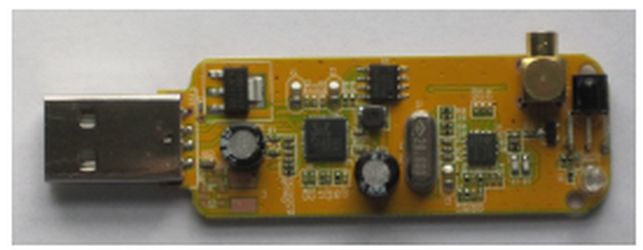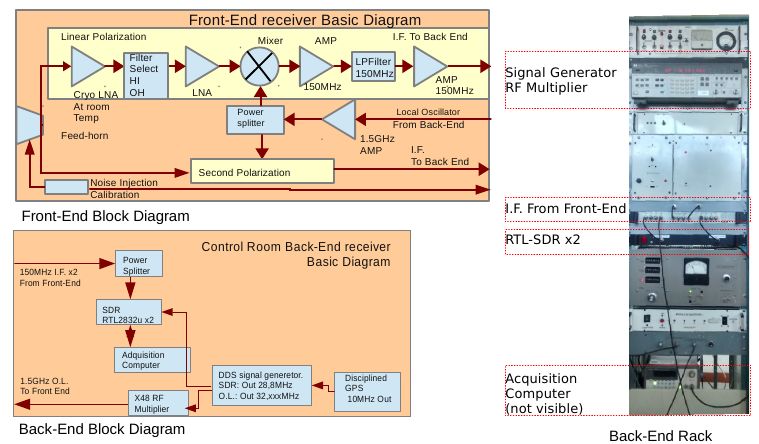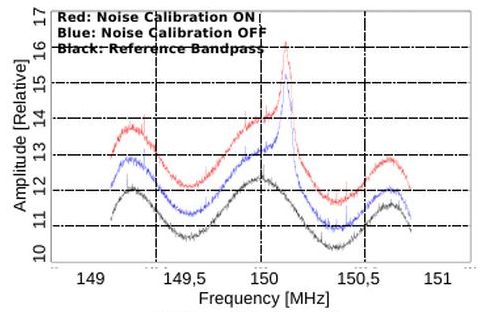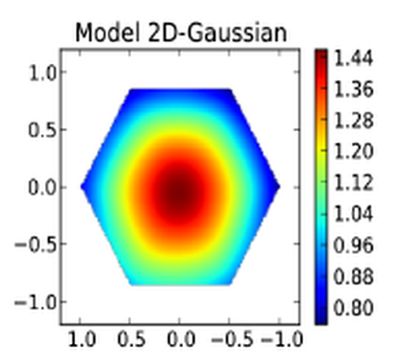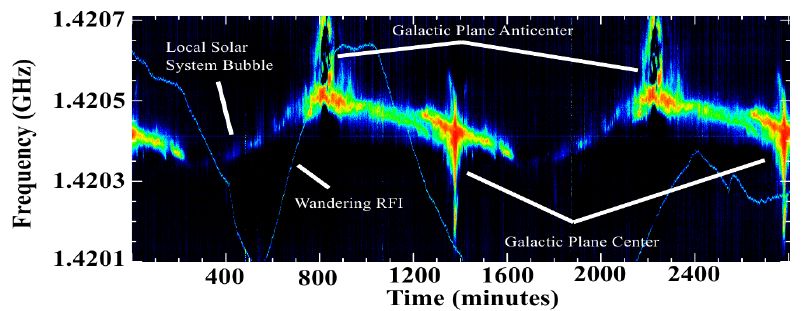
Hydrogen Radio Observations using Software Defined Radio
 Introduction
IntroductionDuring 2014 it was implemented at the IAR a digital receiver for radio astronomy observations, allowing to observe neutral hydrogen spectral profiles and realize total power observations or continuum. This digital receiver uses the advantages of the technology called "Software Defined Radio" or SDR. This technology allows the implementation of programs written in different computer languages, who defines the behavior of the electronic receiver, avoiding the development of new hardware when some new functionality is required.
 Project Description
Project DescriptionIn order to acquire signals from the radio telescope, two SDR receivers were implemented on each polarization, these were installed in the control room of the radio telescope, on the first intermediate frequency stage, with this technology it is possible to reduce electronic devices that are needed to digitize radio signals. The previous digital back end of the hydrogen line receiver used two signal conversion modules and 1008 Auto-channel correlator developed at Arecibo Observatory.
 Software Defined Radio
Software Defined RadioThe SDR systems are a radio devices where typically hardware components such as mixers, filters, amplifiers, sensors, etc., are implemented or described in software, using a personal computer or other embedded computing devices.
Although the concept of SDR is not new, the recent evolution of electronic components and the increasing processing speed, has made possible the practical implementation of this devices.
Unlike a conventional electronic receiver an SDR will have a reduced RF input stage followed by a fast digital conversion and processing of the data is realized in software.
Although the concept of SDR is not new, the recent evolution of electronic components and the increasing processing speed, has made possible the practical implementation of this devices.
Unlike a conventional electronic receiver an SDR will have a reduced RF input stage followed by a fast digital conversion and processing of the data is realized in software.
 Software Description
Software DescriptionThe software used was developed at the IAR with the aim of optimize observation times, it is written in "C" language and it is executed on a Linux platform.
Once the data is received and converted to the necessary format, an FFT function is applied to the data packets for a given unit of time giving as a result their frequency spectrum, this process is repeated during the entire observation time, averaging each "FFT" previously obtained. Also between each unit of acquisition the calibration source is switched, giving a measure of "ON calibration" and "OFF calibration". At the end of the observation and knowing the relative temperature of the calibration device at the antenna, an estimated temperature of the source is obtained.
Once the data is received and converted to the necessary format, an FFT function is applied to the data packets for a given unit of time giving as a result their frequency spectrum, this process is repeated during the entire observation time, averaging each "FFT" previously obtained. Also between each unit of acquisition the calibration source is switched, giving a measure of "ON calibration" and "OFF calibration". At the end of the observation and knowing the relative temperature of the calibration device at the antenna, an estimated temperature of the source is obtained.
 Resulting Observations
Resulting ObservationsIn order to validate the system performance, calibrated radio sources were observed, thus comparing the profiles obtained with cataloged profiles.
The observations presented are not calibrated in amplitude nor in source temperature, this essay seeks to compare the spectral resolution and speed distribution in the profiles.
The observations were made with the following settings:
- Total bandwidth: 2 MHz
- Spectral resolution: 1024 points (FFT)
- Observation time: 5 minutes
The observations presented are not calibrated in amplitude nor in source temperature, this essay seeks to compare the spectral resolution and speed distribution in the profiles.
The observations were made with the following settings:
- Total bandwidth: 2 MHz
- Spectral resolution: 1024 points (FFT)
- Observation time: 5 minutes
 Participants
ParticipantsTéc. Martin Salibe --> msalibe -at- iar.unlp.edu.ar
Téc. Guillermo Gancio --> ggancio -at- iar.unlp.edu.ar


